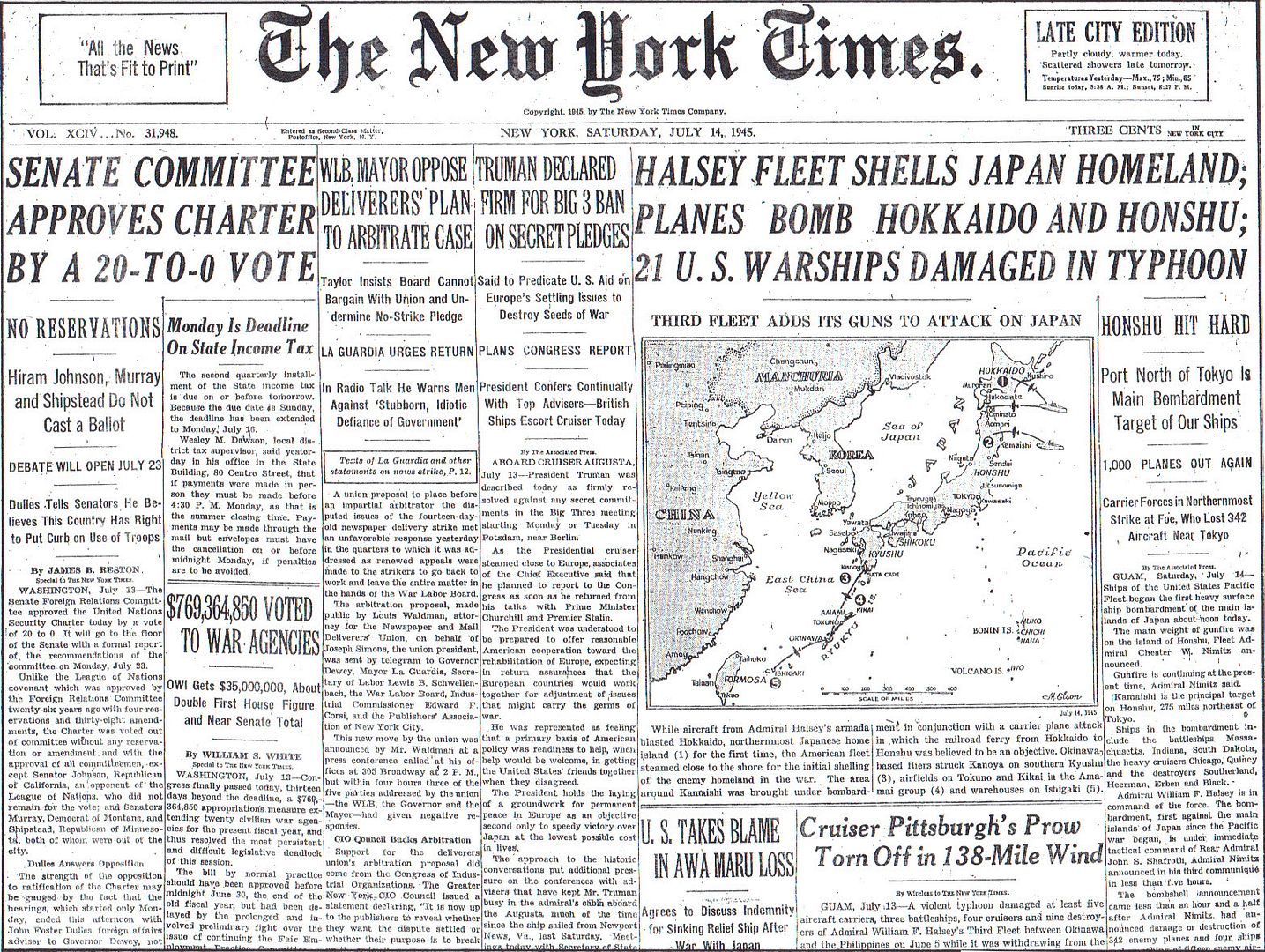
Posted on 07/14/2015 4:58:14 AM PDT by Homer_J_Simpson

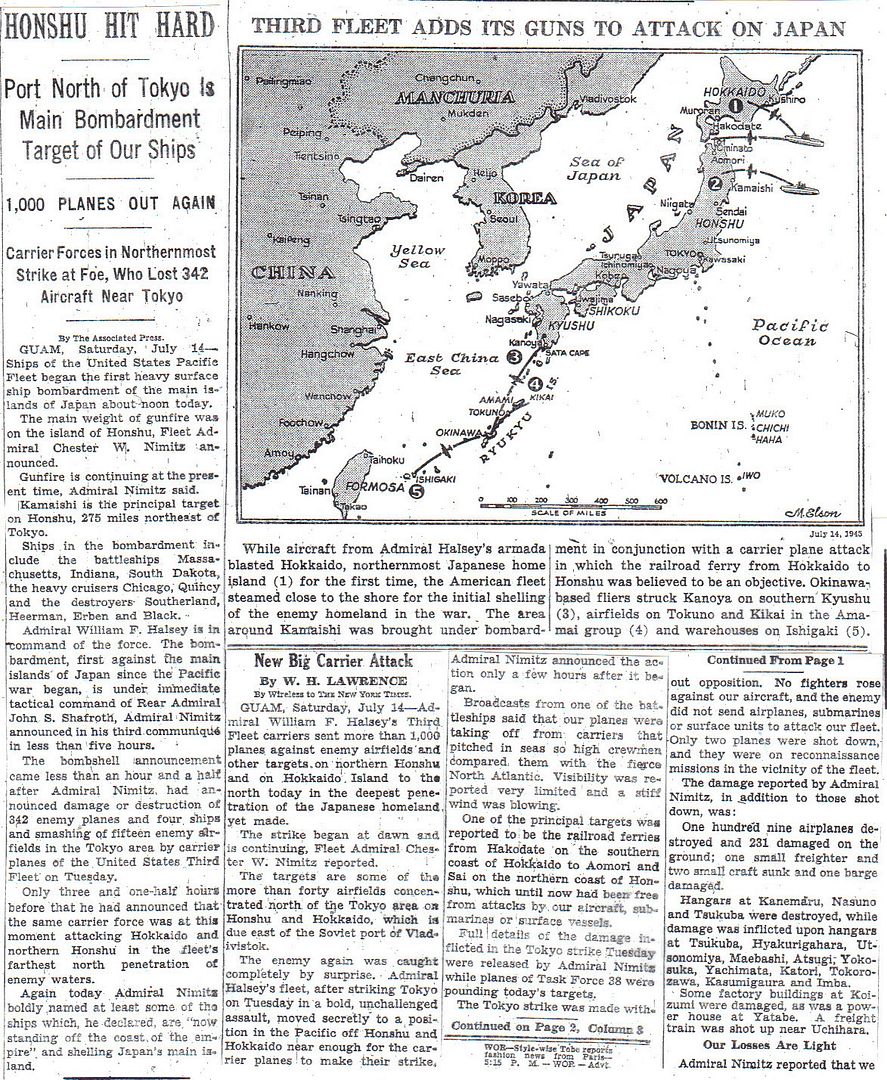
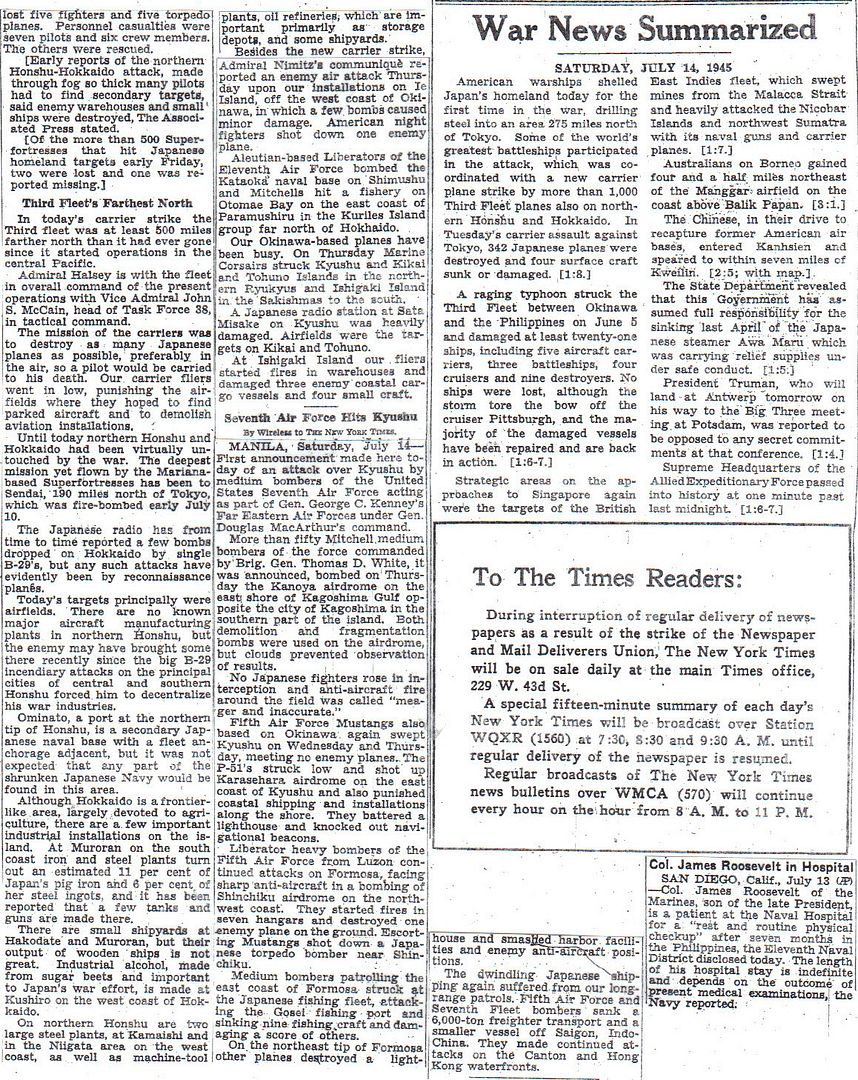
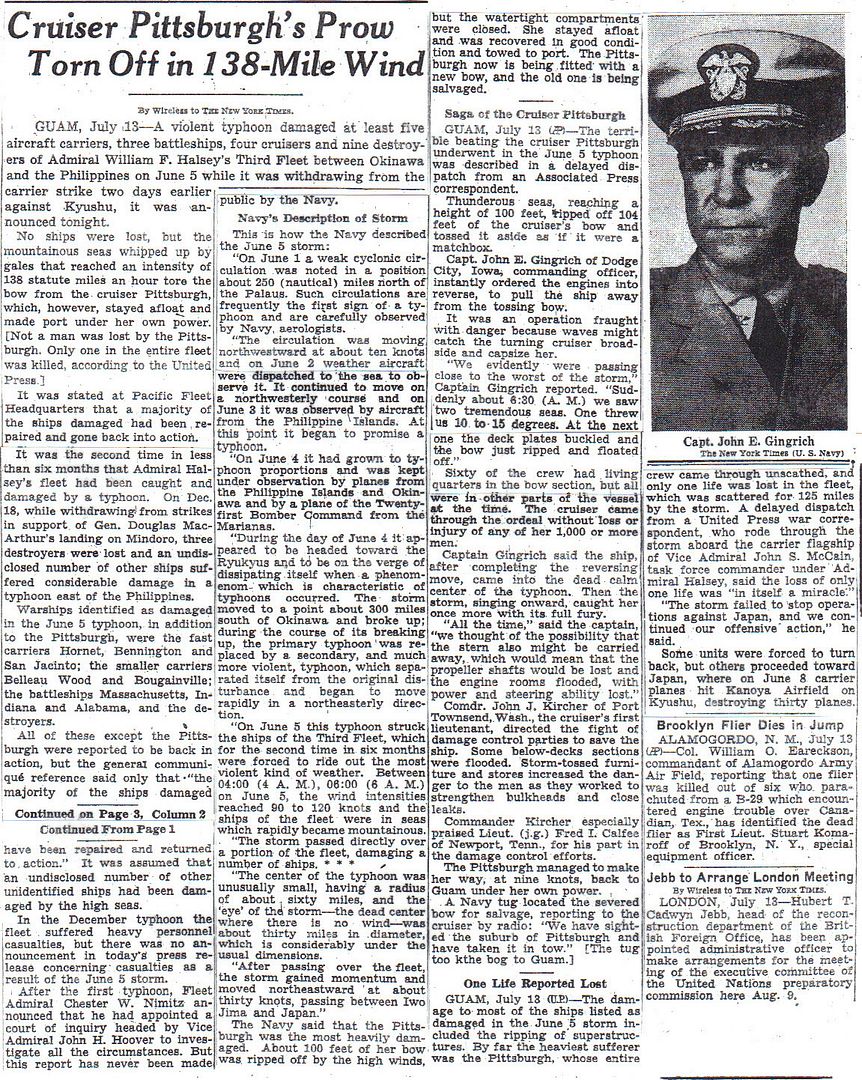

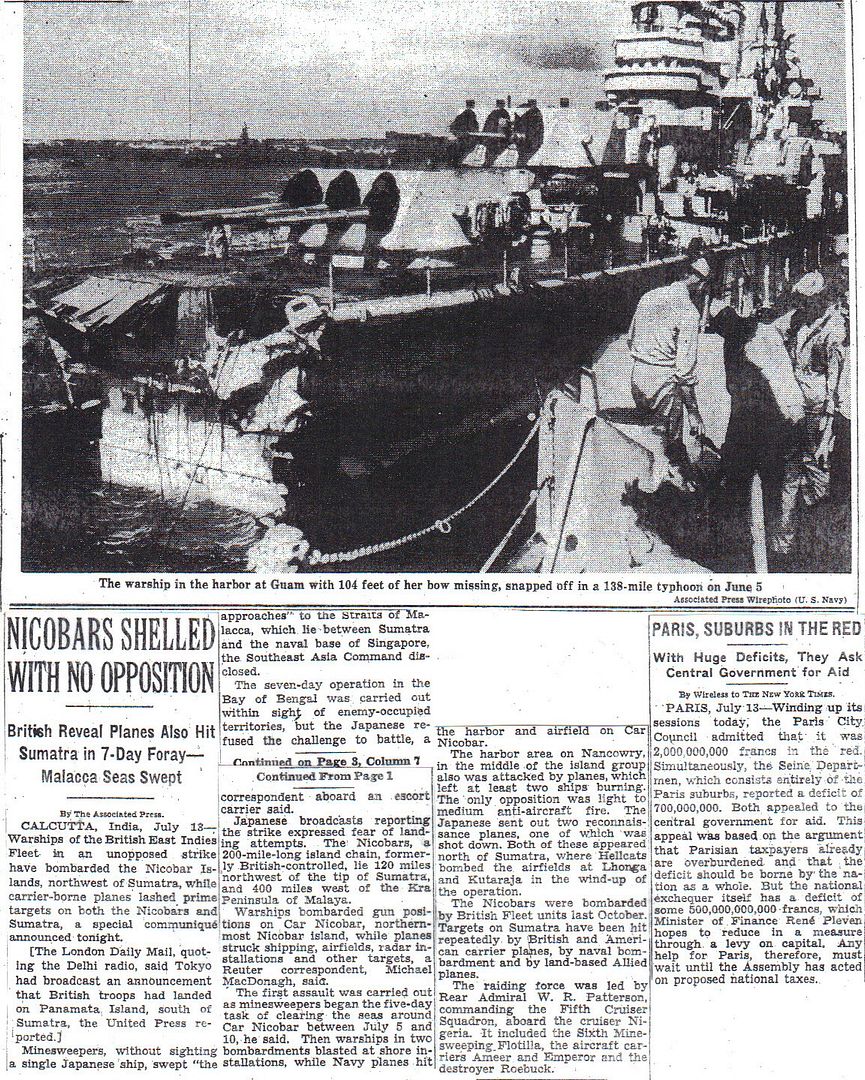
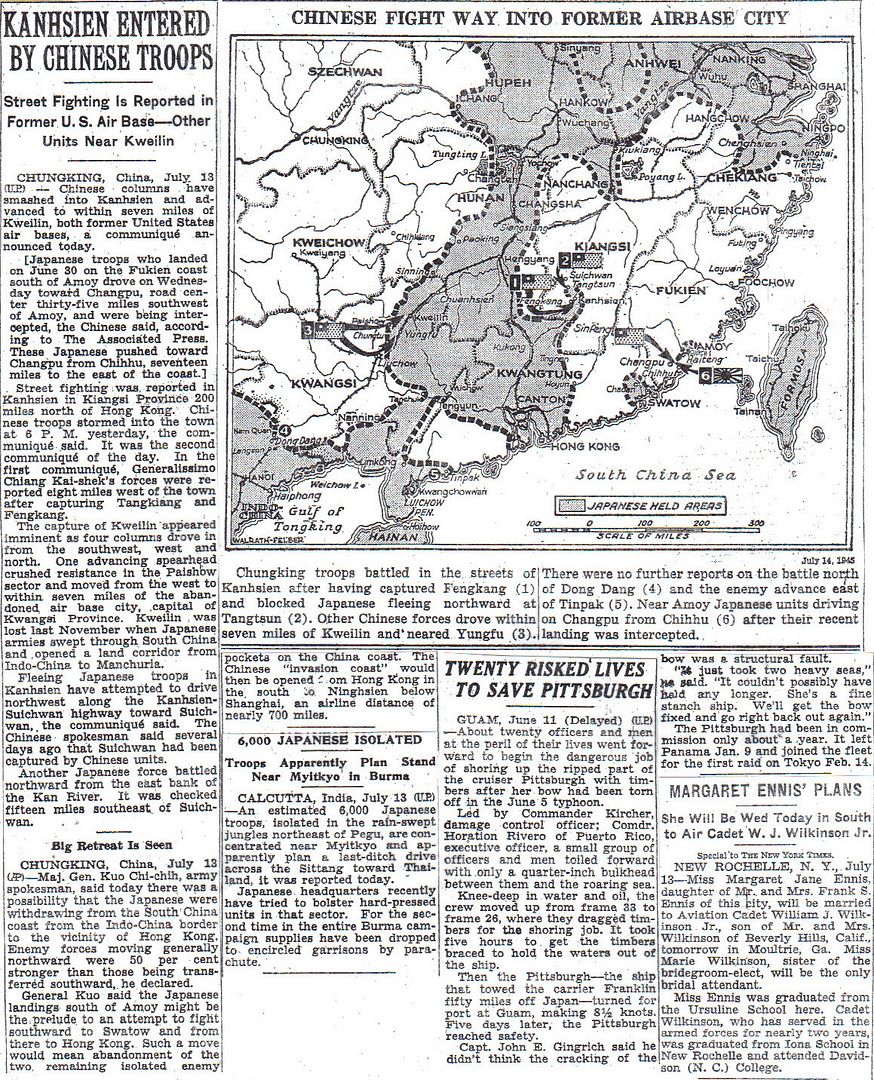
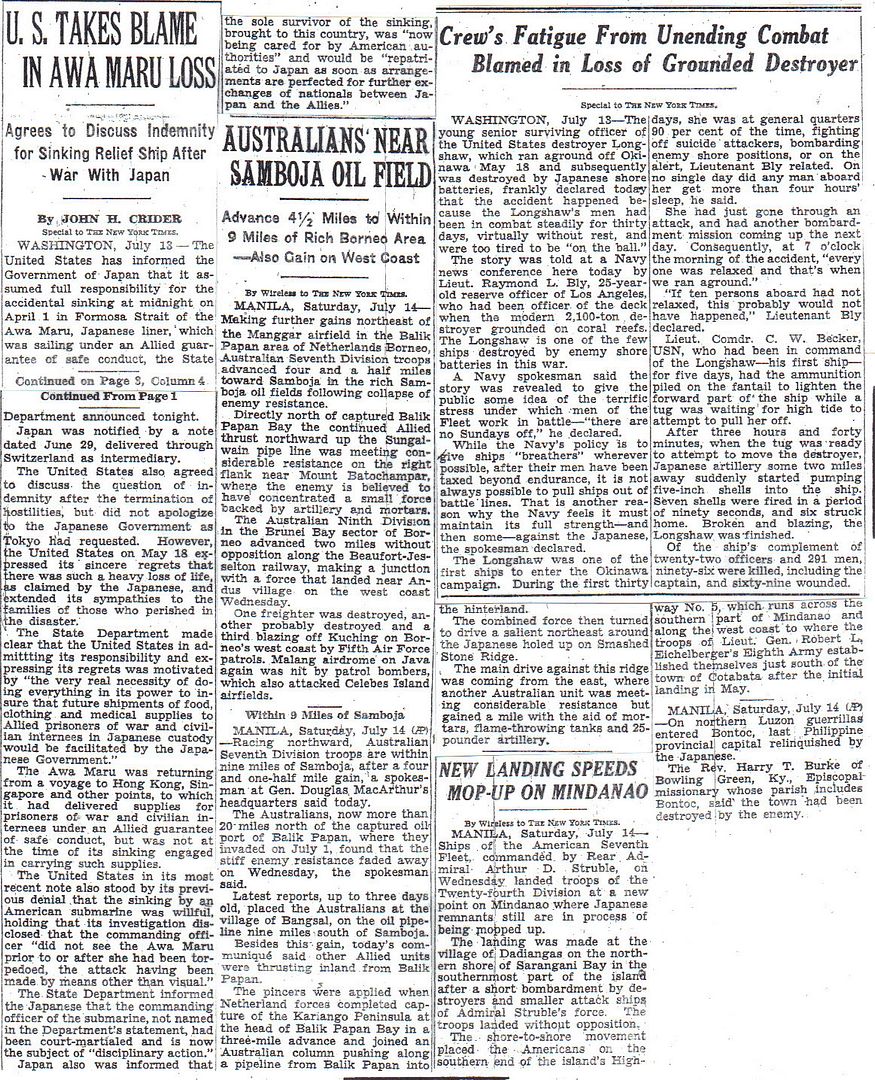
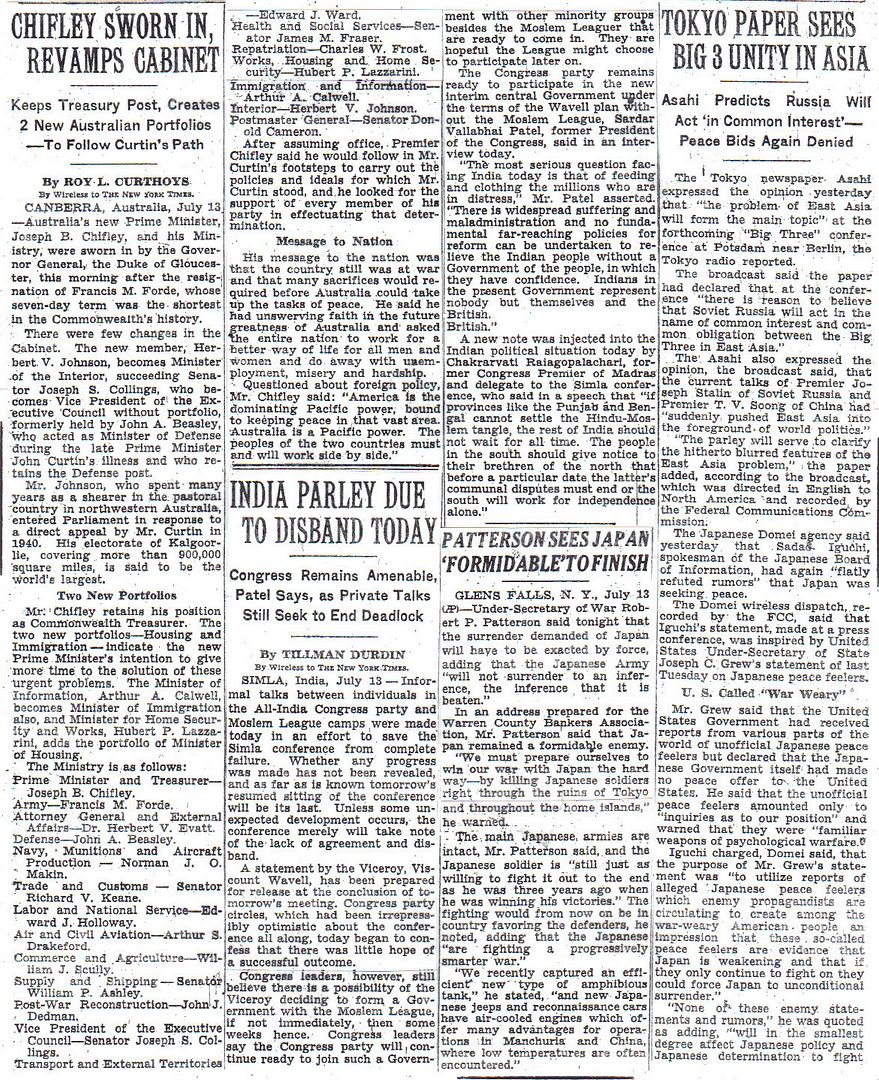
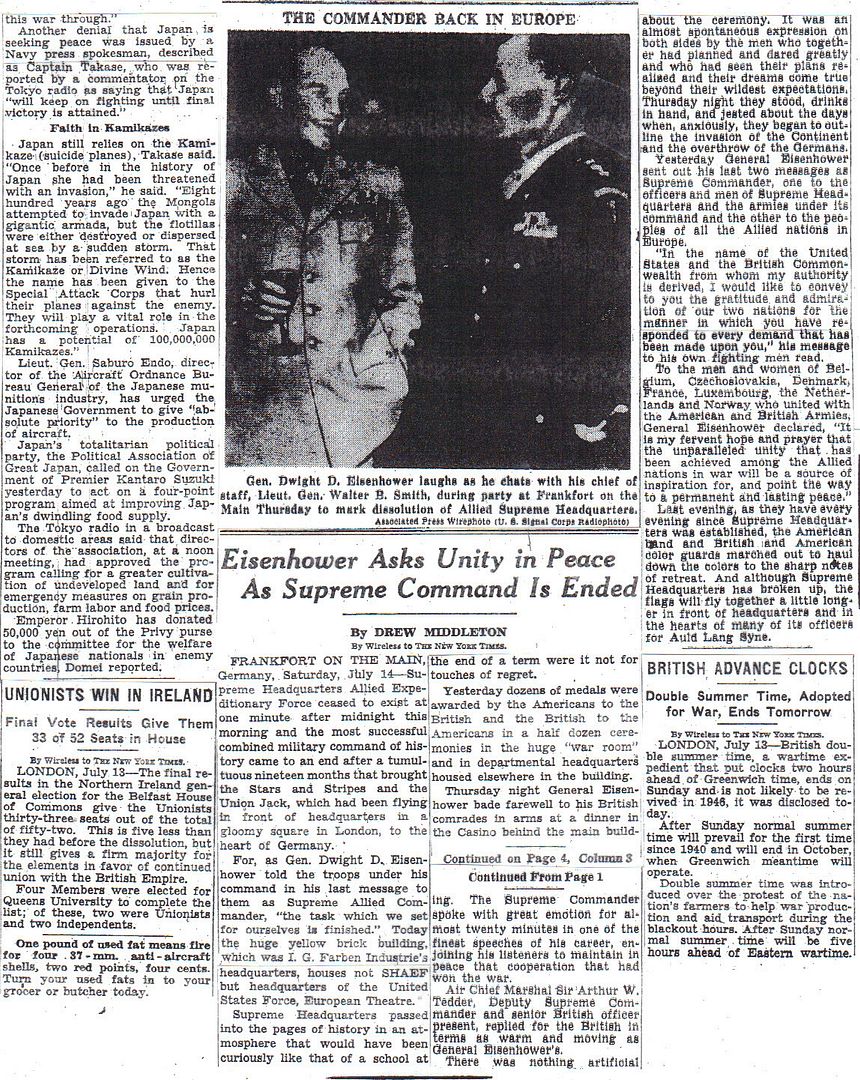
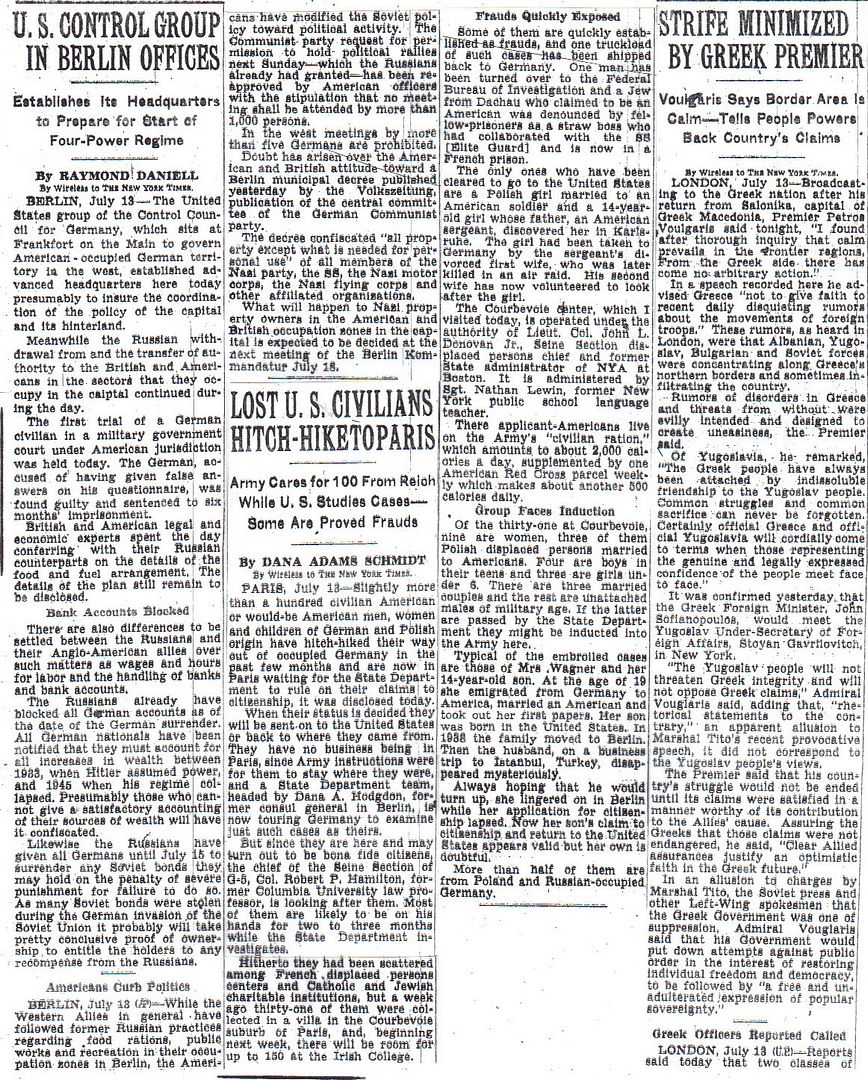

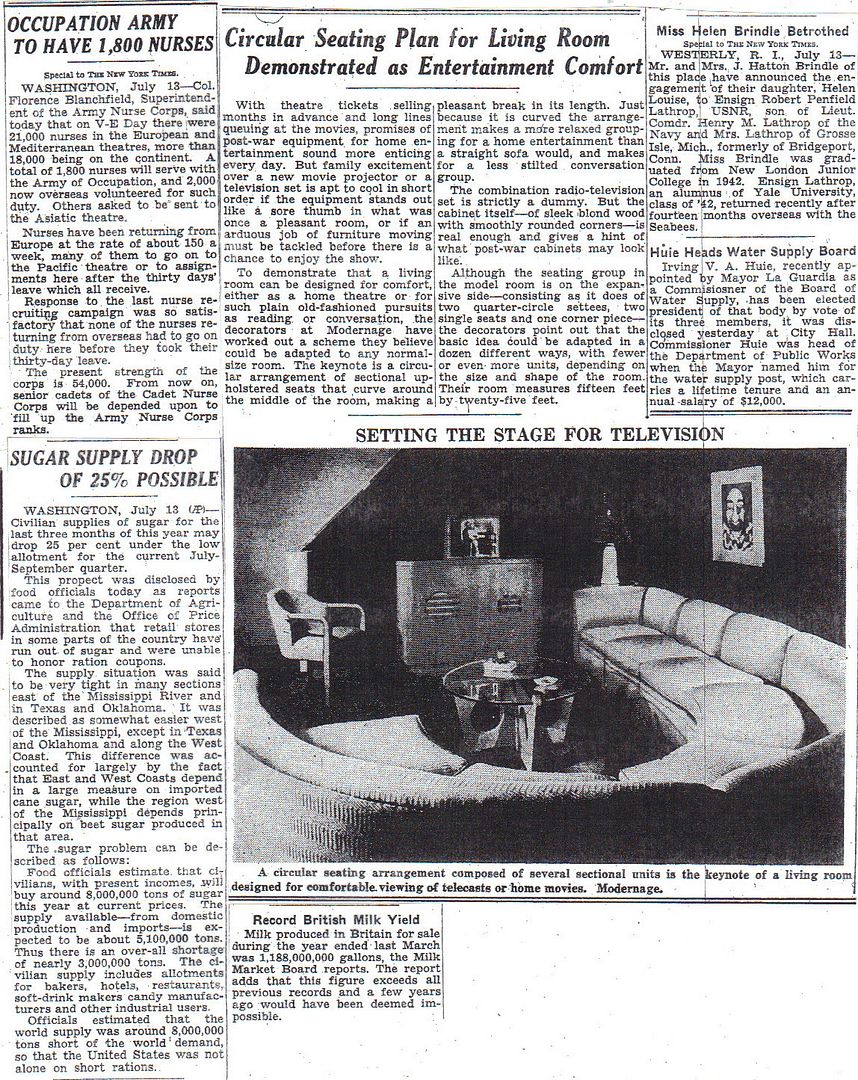
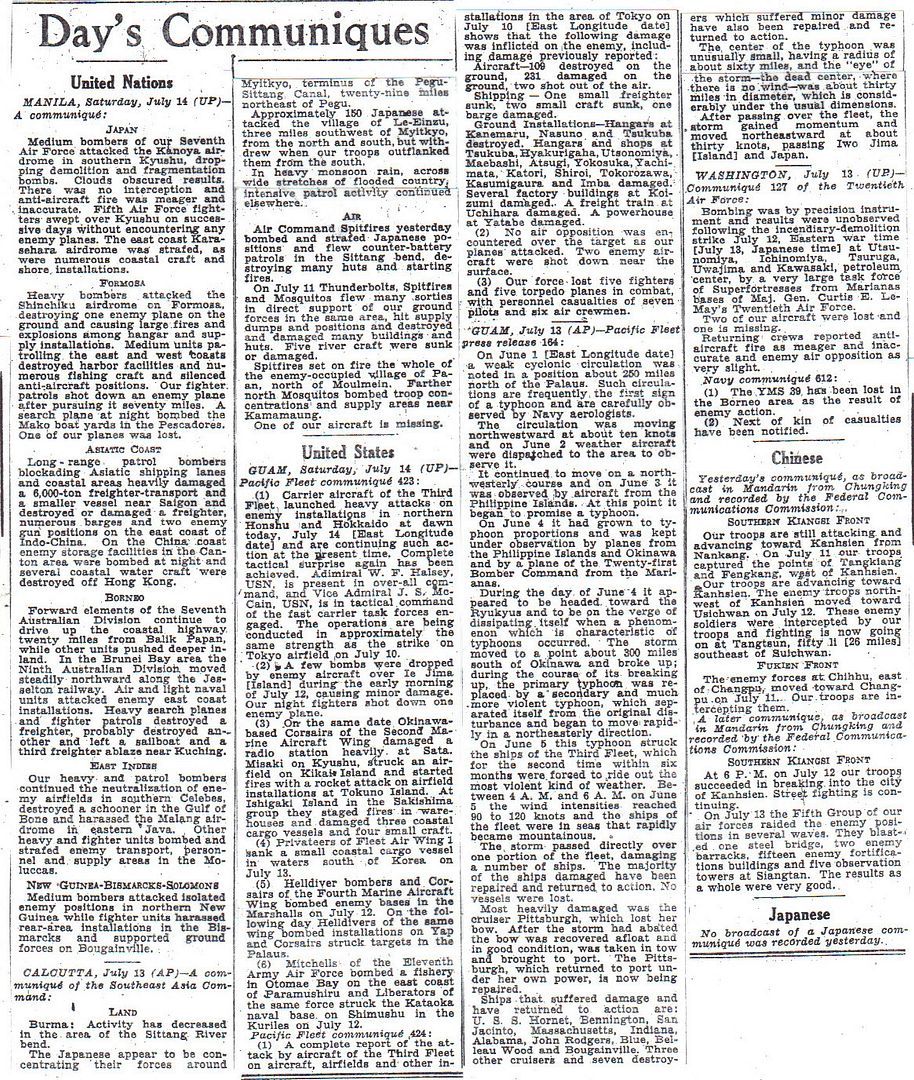
#1 – “Sentimental Journey” – Les Brown, with Doris Day
#2 - “On the Atchinson Topeka & Santa Fe” - Johnny Mercer, with the Pied Pipers
#3 – “There! I’ve Said It Again” – Vaughn Monroe
#4 - “Bell Bottom Trousers” - Tony Pastor, with Ruth McCullough
#5 - “Sentimental Journey” - Hal McIntyre
#6 - “Chopin’s Polonaise” - Carmen Cavallaro
#7 – “Sentimental Journey” – Merry Macs
#8 - “Bell Bottom Trousers” - Guy Lombardo, with Jimmy Brown
#9 – “You Belong to My Heart” – Bing Crosby, with Xavier Cugat Orchestra
#10 - “Gotta Be This Or That” - Benny Goodman
http://www.etherit.co.uk/month/6/14.htm
July 14th, 1945 (SATURDAY)
GERMANY: Koningsee: Eisenhower dissolves the Supreme Headquarters, Allied Expeditionary Force (SHAEF).
ITALY: Rome: Italy declares war on Japan.
JAPAN: Carrier-based aircraft of the USN’s Task Force 38 are prevented from attacking airfields in northern Honshu and Hokkaido by bad weather so they strike shipping, rail lines and ground installations in those areas.
The USN’s Task Unit 34.8.1 under Rear Admiral John F. Shafroth, composed of three battleships SOUTH DAKOTA, INDIANA, MASSACHUSETTS, two heavy cruisers (QUINCY and CHICAGO) and nine destroyers, bombard the ironworks at Kamaishi on northern Honshu. This is the first naval bombardment of the Japanese home islands. 802 16-inch, 728 8-inch and 825 5-inch rounds were expended. (Keith Allen)
USAAF XXI Bomber Command P-51s from Iwo Jima sent on a strike against Meiji and Kagamigahara in the Nagoya, Japan area abort because of weather.
Japanese aircraft losses are: 1 A/C shot down; 1 damaged in air combat; 24 a/c destroyed on the ground; 62 a/c damaged on the ground.
Japanese shipping losses are: Sunk: 1 Escort Destroyer, 3 Corvettes, 1 Submarine Chaser, 1 Minesweeper, 4 Auxiliary Minesweepers, 5 Guardboats, 1 Gunboat, 1 Transport, 1 Army Vessel, 12 Merchant Cargo Vessels, 7 Train Ferries, and 8 luggers.
Damaged: 1 Destroyer, 2 Corvettes, 1 Frigate, 2 Submarine
Chasers, 1 Auxiliary Submarine Chaser, 2 Auxiliary Minesweepers, 1 Guardboat, 3 Army Vessels, 3 Train Ferries, 15 Merchant Cargo Vessels, 2 Merchant ankers, 1 Dredger, and 2 luggers.
US A/C losses: Combat: VF/VBF - 6; VT = 4; VB=6; Total = 16 Operational: VF/VBF = 6; VT = 2; VB = 3; Total = 11; Aircrew: VF/VBF = 4 Pilots, VT = 2 Pilots 4 Crew; VB = 4 Pilots, 4 Crew. (Jack McKillop and Rich Leonard)
On this date, HQ Seventh Air Force officially joins the Fifth and Thirteenth Air Forces as part of the Far East Air Forces (FEAF).
PACIFIC OCEAN: Japanese submarine I-351 is sunk by USS Bluefish in the South China Sea. (Mike Yared)(144 and 145)
CANADA: Destroyer HMCS St Francis (ex USS Bancroft) while under tow to Philadelphia sank off Sagonnet Point, Rhode Island following collision SS Winding Gulf.
Corvettes HMCS Chilliwack and Fredericton paid off Sorel, Province of Quebec.
Corvette HMCS Fergus, HMC ML 058, ML 065 and ML 108 paid off Sydney, Nova Scotia.
U.S.A.: Washington: GIs may “fraternize” with civilians in the American zone of Germany within carefully-defined limits under a scheme prepared by General Eisenhower, to be presented as part of an Allied plan for unified control of the country. Fraternization is forbidden in the British Army. However, the rumour among the troops is that if you offer a Fraulein a bar of chocolate you can get anything you like - and six eggs for change.
Escort carrier USS Rabaul launched.
Destroyer USS Glennon launched. (DS)
Ominato (大湊 meaning "big port") was the guard station for the IJN in Mutsu Bay, on the Tsuruga Straits between Honshu and Hokkaido. It took a number of bombing runs to inflict sufficient damage upon the port, including a major run that coincided with the Nagasaki bombing, August 8-10. By that time the main concern wasn't about preparation for an American invasion, but trying to stop a likely Soviet invasion from the north: if the Soviets had been able to take over the Ominato facility it would have given their navy access to the northern half of Japan, and Truman was trying to keep Japan from being cut in two, just as Germany had been.
I still wonder why there aren't any Superforts flying out of Adak or Kiska. Guam to Tokyo is 2500 miles, while Kiska to Sapporo is only 1700 miles, and Adak (which would be easier to supply) to Sapporo is only 2000 miles. Despite what one might think of Alaska, the island chain is relatively moderate in temperature--in July, the lows are around 40 and the highs near 60--and getting fuel from Canada via tankers would have been easy, especially since the IJN was concentrated in the south. We could easily have destroyed facilities like Ominato, and the larger cities of Sapporo, Aomori, and Morioka, from Adak or Kiska.
It might have had something to do with MacArthur's concerns about the Philippines skewing the strategic planning. IIRC Nimitz wanted to bypass the Philippines and strike at Formosa, which would have made more strategic sense, though at the cost of leaving behind the Filipinos and our POWs, and that would have been a tough call to make at the time.
Incidentally, if you want to see the Queenfish, look at the opening scenes of the 1959 movie Operation Petticoat, where it was used for the exterior shots.
Buried today in the Nimitz Graybook is one of the most strategic airstrikes conducted in this war, little noted at the time, but which revealed much about the tenuous transport links which the Japanese war economy depended upon. Those were the rail ferries linking Hokkaido and Honshu.
Honshu contained much of Japan’s heavy industry, which was dependent on supplies of coal for power and for steel-making. Japanese coal, of good quality and sufficient quantity, was located on Hokkaido. As Japan industrialized in the 1920s and 1930s, they faced the problem of transporting coal from Hokkaido to Honshu across the Tsugaru Strait. The solution was the construction of 12 large rail ferries, which transported the coal hoppers from the Hokkaido rail net to the Honshu rail net. It enabled an efficient transport without having to offload and reload the coal hoppers.
Today (or yesterday in Japan), Halsey’s carrier aircraft attacked those twelve rail ferries. The results were much better than the Graybook indicates. Eight ferries were sunk, two badly damaged and two were beached. Coal deliveries to Honshu were cut by 80% by these attacks. That means Japanese industrial production and electrical generation will pretty much cease once the supply of coal on hand has been exhausted.
By cutting this one vital, and vulnerable, economic link, the last remaining source of energy for Japanese industry and their economy has been eliminated. Think about the ramifications for keeping a starving, homeless population warm in the coming winter.
Fascinating! I figured they were using Manchurian/Korean coal, didn’t think there was enough in Hokkaido to make a difference.
I think they were using the Manchurian/Korean coal exclusively for the steel works at Yawata on Northern Kyushu. Honshu was almost exclusively dependent on coal from Hokkaido.
Given the air patrols we are now mounting from Okinawa, I doubt much is getting through to Kyushu, either.
Until now, the coal ferries were considered out reach of American air power. It’s pretty clear now that nothing is out of reach of American air power.
Laughlin must have been one hell of an officer to survive the wrath of Fleet Admiral Chester Nimitz and go on to a successful career, attaining flag rank.
I thought the wording of #8 was slightly ambiguous. Was Nimitz angry at the Court Martial board for the lightness of the penalty or its harshness?
The key facts were that Laughlin did not receive the pertinent messages due to atmospheric interference. The weather at the time of attack was very dirty with 200 yards visibility. He attacked with the stern tubes because he though he was attacking a destroyer and not a big freighter.
Vice Admiral Lockwood got him a good lawyer and testified on his behalf. Lockwood was not only a brilliant commander but was also a stand up guy.
The Court issued Laughlin a letter of admonition. Nimitz was so pissed he issued the Members letters of reprimand - harsher than Laughlin got.

As for Loughlin, he did make it to rear admiral, but that was partly because Lockwood had his back, partly because Nimitz headed to Germany soon after and then "retired" in '47--technically a Fleet Admiral never retires, but he wasn't involved in any command decision making after that--and partly because he was able to wrangle high-level staff positions, even though Nimitz swore he would never have a command again. Loughlin could easily have made Vice Admiral otherwise. Reminds me a little of John Wayne's Rockwell Torrey character in In Harm's Way: made the right command decision, ended up with the wrong result, and had to deal with desk-sitters for the rest of his career.
Akushitsu na yorokobi (悪質な喜び)
It's a direct translation meaning "malicious happiness." I don't know of any specific term, and the word itself doesn't seem to have become part of the Japanese language (something like シャディンフロイド、shadinfuroido), as other foreign words have.
Disclaimer: Opinions posted on Free Republic are those of the individual posters and do not necessarily represent the opinion of Free Republic or its management. All materials posted herein are protected by copyright law and the exemption for fair use of copyrighted works.